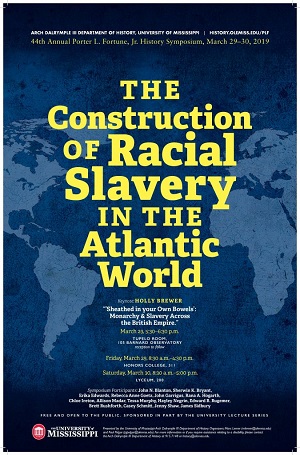
2019: The Construction of Racial Slavery in the Atlantic World
From Creole to African in the Ceded Islands: Experiencing Transformations in Slavery after the Seven Years’ War
Document Type
Event
Location
Lyceum 200
Start Date
30-3-2019 2:30 PM
End Date
30-3-2019 3:15 PM
Description
In the wake of the Seven Years’ War (1756-1763), the Caribbean islands of Dominica, Grenada, St. Vincent, and Tobago were assimilated into the expanding British Empire. Although Grenada was formerly a peripheral colony of France, the other three islands had developed for decades outside the sphere of European rule. All four were sparsely populated, lacked infrastructure such as roads, and relied on small, mixed-agriculture estates rather than the large sugar plantations found in colonies such as Barbados. The British Crown wasted little time in trying to transform some of the last unclaimed lands in the Caribbean into centers of plantation production. Between 1763 and 1773, more than 80,000 enslaved people were trafficked to what officials collectively referred to as 'the Ceded Islands.' Saltwater slaves quickly dwarfed the archipelago's existing population of 23,000 predominantly Caribbean-born slaves and radically transformed the physical landscape, demography, and economy of the region.
This paper explores the immediate effects of the formal extension of the transatlantic slave trade to the Ceded Islands. While some attention has recently been paid to British designs for the islands, as well as their key role in the inter-colonial slave trade, historians have yet to explore the human dimensions of this transformation. Drawing on the Transatlantic Slave Trade Database, British Parliamentary House of Commons Sessional Papers, and government censuses and correspondence, the focus of this paper is on the lived experiences of the enslaved. Who were some of the 80,000 children, women, and men who disembarked in the Ceded Islands in the decade after the Seven Years' War, and what were their lives like after they were trafficked? What kinds of labor were they forced to perform in the new colonies, and how did that shape where they lived and with whom, what they ate and drank, and the kinds of relationships they forged? How did the islands' existing populations (both enslaved and free) view and interact with the newcomers? Rather than focusing on the rapid economic development of some of the last Caribbean islands to be colonized, this paper foregrounds the experiences of people whose forced labor fueled this development.
Relational Format
Conference Proceeding
Recommended Citation
Murphy, Tessa, "From Creole to African in the Ceded Islands: Experiencing Transformations in Slavery after the Seven Years’ War" (2019). Porter L. Fortune, Jr. Symposium. 4.
https://egrove.olemiss.edu/plf/2019/schedule/4
From Creole to African in the Ceded Islands: Experiencing Transformations in Slavery after the Seven Years’ War
Lyceum 200
In the wake of the Seven Years’ War (1756-1763), the Caribbean islands of Dominica, Grenada, St. Vincent, and Tobago were assimilated into the expanding British Empire. Although Grenada was formerly a peripheral colony of France, the other three islands had developed for decades outside the sphere of European rule. All four were sparsely populated, lacked infrastructure such as roads, and relied on small, mixed-agriculture estates rather than the large sugar plantations found in colonies such as Barbados. The British Crown wasted little time in trying to transform some of the last unclaimed lands in the Caribbean into centers of plantation production. Between 1763 and 1773, more than 80,000 enslaved people were trafficked to what officials collectively referred to as 'the Ceded Islands.' Saltwater slaves quickly dwarfed the archipelago's existing population of 23,000 predominantly Caribbean-born slaves and radically transformed the physical landscape, demography, and economy of the region.
This paper explores the immediate effects of the formal extension of the transatlantic slave trade to the Ceded Islands. While some attention has recently been paid to British designs for the islands, as well as their key role in the inter-colonial slave trade, historians have yet to explore the human dimensions of this transformation. Drawing on the Transatlantic Slave Trade Database, British Parliamentary House of Commons Sessional Papers, and government censuses and correspondence, the focus of this paper is on the lived experiences of the enslaved. Who were some of the 80,000 children, women, and men who disembarked in the Ceded Islands in the decade after the Seven Years' War, and what were their lives like after they were trafficked? What kinds of labor were they forced to perform in the new colonies, and how did that shape where they lived and with whom, what they ate and drank, and the kinds of relationships they forged? How did the islands' existing populations (both enslaved and free) view and interact with the newcomers? Rather than focusing on the rapid economic development of some of the last Caribbean islands to be colonized, this paper foregrounds the experiences of people whose forced labor fueled this development.

